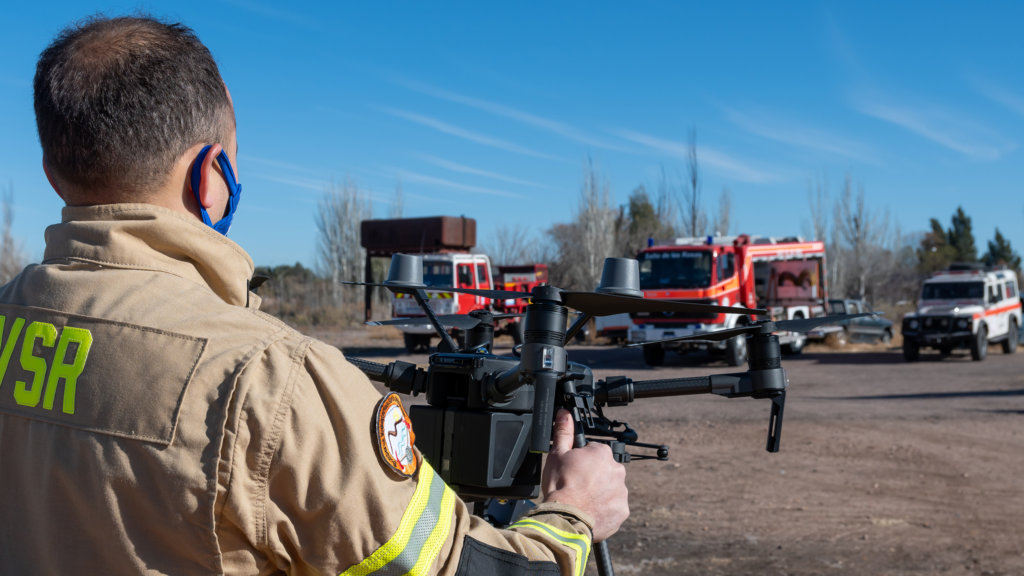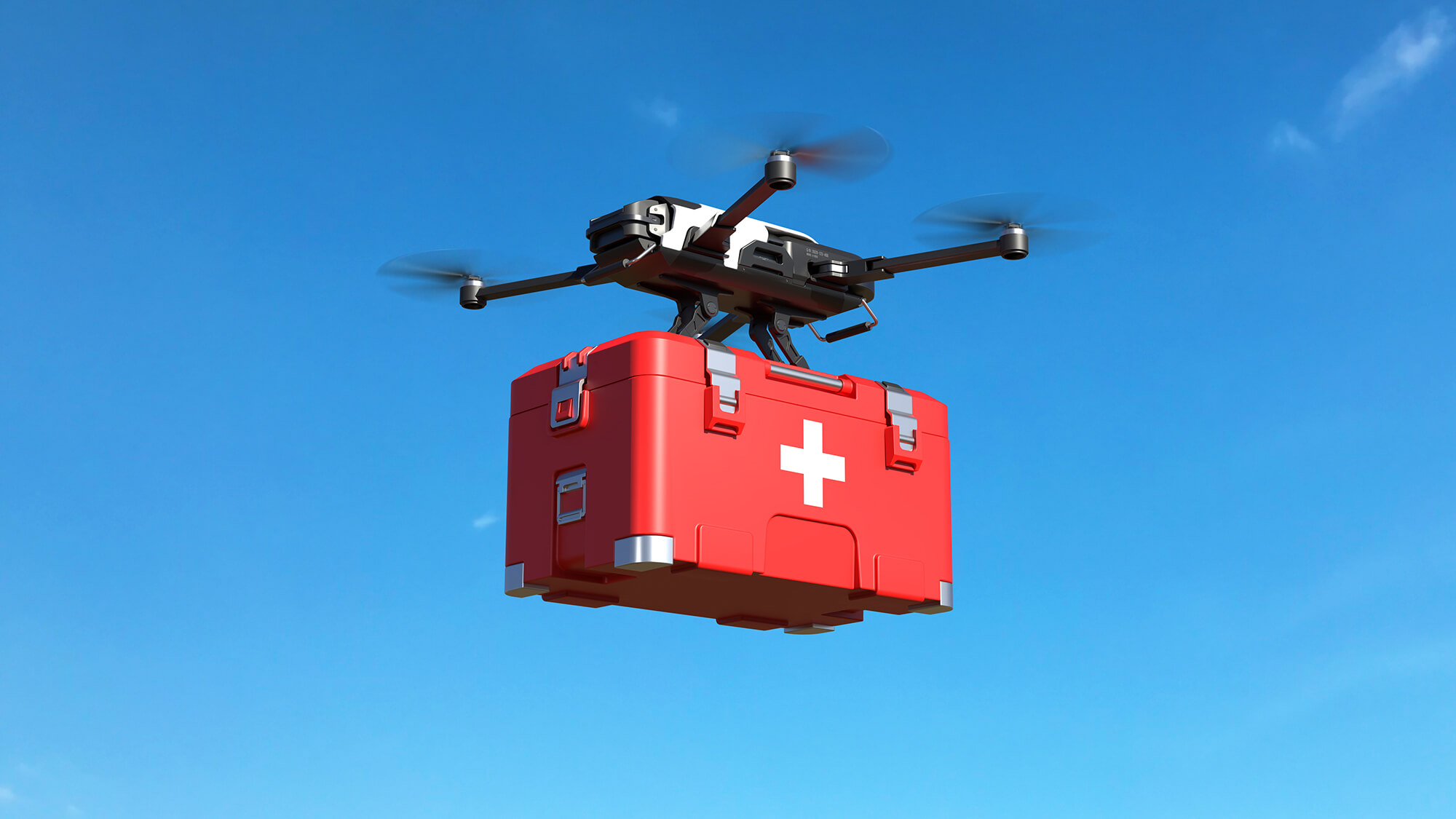When you think of drones, medical deployments probably aren’t top of mind. But the list of use cases for drones is growing by the day, and healthcare is one of the most exciting emerging markets.
Today, more and more healthcare providers are turning to ambulance drones to streamline emergency response. And this trend is having a profound impact on the medical industry. By using drones, healthcare providers are extending their reach into local communities and saving more lives.
This post examines everything you need to know about what ambulance drones do and how medical teams are using them to reach patients faster.
What Is an Ambulance Drone?
An ambulance drone is a type of unmanned aerial vehicle (UAV) that medical teams use to deliver essential supplies and care in emergency situations.
For example, medical emergencies like cardiac arrest and severe abrasions require immediate support. Despite this, it can take several minutes for nearby medical teams to reach those in need. Oftentimes, emergency medical teams arrive too late for reasons beyond their control. And when this happens, it can mean permanent damage or loss of life.
Since the first few minutes are so important during an emergency, medical teams are constantly looking for ways to reach people faster. And this is where ambulance drones come into play. These small devices can transport lifesaving technologies—like medication, CPR kits, and even automated external defibrillators (AEDs)—making it easier to provide rapid-response care.
What Are the Benefits of an Ambulance Drone?
Drones come with a variety of benefits, making them a transformative technology for any medical response team.
With that in mind, let’s take a look at some of the top benefits that come with using drones during medical emergencies.
Accelerate Response Times
Ambulance drones can avoid traditional transportation barriers like traffic jams and blocked roads. Due to their nature, they can fly directly to patients instead of navigating congested paths.
By using drones to respond to medical incidents, teams can transport items before personnel arrives on the scene. This, in turn, allows patients, family members, and friends to receive immediate treatment instead of having to wait—perhaps too long—for help to arrive.
Reach Difficult Places
Oftentimes, emergencies happen in remote areas, in places that are difficult to reach. To illustrate, a hiker with a severe bee allergy may get stung in the woods, several miles away from the nearest parking lot, and even farther from the nearest hospital. Similarly, someone could have a heart attack on the 20th floor of a building.
Both cases present significant logistical hurdles for emergency responders. But drones can arrive on the scene much faster by taking a direct route to the person through the air while transporting critical supplies. This can buy time before responders can arrive, greatly improving the chances of survival.
Expand Operations
Ambulances are expensive. In addition to their price tag, they also require human operators, technicians, and medical staff. This makes it very difficult for hospitals to add new units and expand their footprints with any sense of urgency.
On the other hand, ambulance drones are much more affordable and require fewer people to operate. Hospitals can use drones to expand their operations and cover more ground. As a result, hospitals are able to serve nearby communities more effectively.
Scale Efficiently
Medical responders need to keep a close watch on shifting populations, especially in areas with seasonal changes and heavy tourism.
For example, consider a coastal town that draws tons of tourists in the summer but clears out in the winter. In this type of scenario, a medical response team could strategically place more drones in the area for faster triage. They could then scale down when populations decrease during the off-season.
Drones can also help during large events like fairs and festivals, where issues like heat stroke and substance abuse may occur. In these types of settings, medical teams can add nearby drones during events and then scale down when they conclude.
Drones can also help during large events like fairs and festivals, where issues like heat stroke and substance abuse may occur
Support Digital Transformation
Emergency medical teams have a responsibility to remain on the cutting edge of technology and innovation. This is necessary in order to provide the best possible treatment.
Drones are a simple, effective, and affordable technology, making them a viable option for medical providers of all sizes. Adding drones is a great way to modernize your emergency response fleet and make your organization more resilient, efficient, and flexible.

Improve Disaster Response
The world is constantly changing, which is challenging emergency response teams to remain agile and up to date with the latest threats. The most recent example is COVID-19, which is forcing providers to find new ways of responding and treating large numbers of patients safely and securely.
Drones can help provide surveillance and treatment following events, helping locate victims and provide on-site medical response. By using drones, medical providers can have an easier time collecting data and understanding where to send support teams. This can expedite emergency response and help conserve resources.
Enhance Battlefield Safety
Providing emergency medical response can be immensely challenging for military personnel, especially during live combat scenarios involving multiple team members. Medical teams often put their own lives on the line transporting supplies and providing emergency care for wounded soldiers.
Thanks to drones, military medical teams can rush supplies to other team members without directly crossing combat zones. By taking this approach, it is possible to transmit critical items like bandages and medicine to other team members while reducing the potential for further injury or harm.
Are Ambulance Drones in the Field Today?
While ambulance drones may seem like futuristic technology, the fact is they are already here.
Believe it or not, many healthcare providers are now using ambulance drones to collect data and save lives. They are becoming increasingly popular as the cost of drones drops and the technology improves.
Medical providers often want to know whether ambulance drones can transport people to emergency response centers. Up until recently, this was not possible. First-generation ambulance drones primarily transport medical supplies and are too small to transport humans. At this point, we are still a few years away from the point where passenger drones become commercially available.
Nevertheless, drones are evolving and some companies are now experimenting with different ways of using drones to transport people. One of the most noteworthy examples is EHang, which is now dispatching passenger drones for COVID-19 response in China.
Believe it or not, many healthcare providers are now using ambulance drones to collect data and save lives
Unquestionably, passenger ambulance drones will become increasingly viable thanks to beyond visual line of sight (BVLOS) technology, which allows drones to safely fly and transport objects over large distances. In a BVLOS deployment, drone operators don’t have to maintain direct visibility with the vehicle. As a result, BVLOS drones can travel farther distances and go beyond obstructions like buildings and mountains.
How Iris Automation Can Help Your Company Maximize Its Drone Investments
Suffice it to say that drones can be a bit overwhelming at first if you’re not experienced using them. But with the help of a trusted enabler like Iris Automation, your company can integrate drones easily and affordably—putting your organization in a much stronger position because of it.
Iris Automation specializes in helping companies adopt cutting-edge BVLOS drones, allowing them to deploy drones faster, more safely, and across greater distances. Iris Automation works with many industries, including utilities, transportation, agriculture, search and rescue, and package delivery. And new use cases are constantly emerging in response to changing market needs.
For a complete breakdown of how Iris Automation can help your organization accomplish more with drones, check out our use cases.
This post was written by Justin Reynolds. Justin is a freelance writer who enjoys telling stories about how technology, science, and creativity can help workers be more productive. In his spare time, he likes seeing or playing live music, hiking, and traveling.

